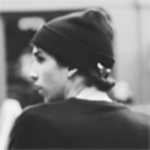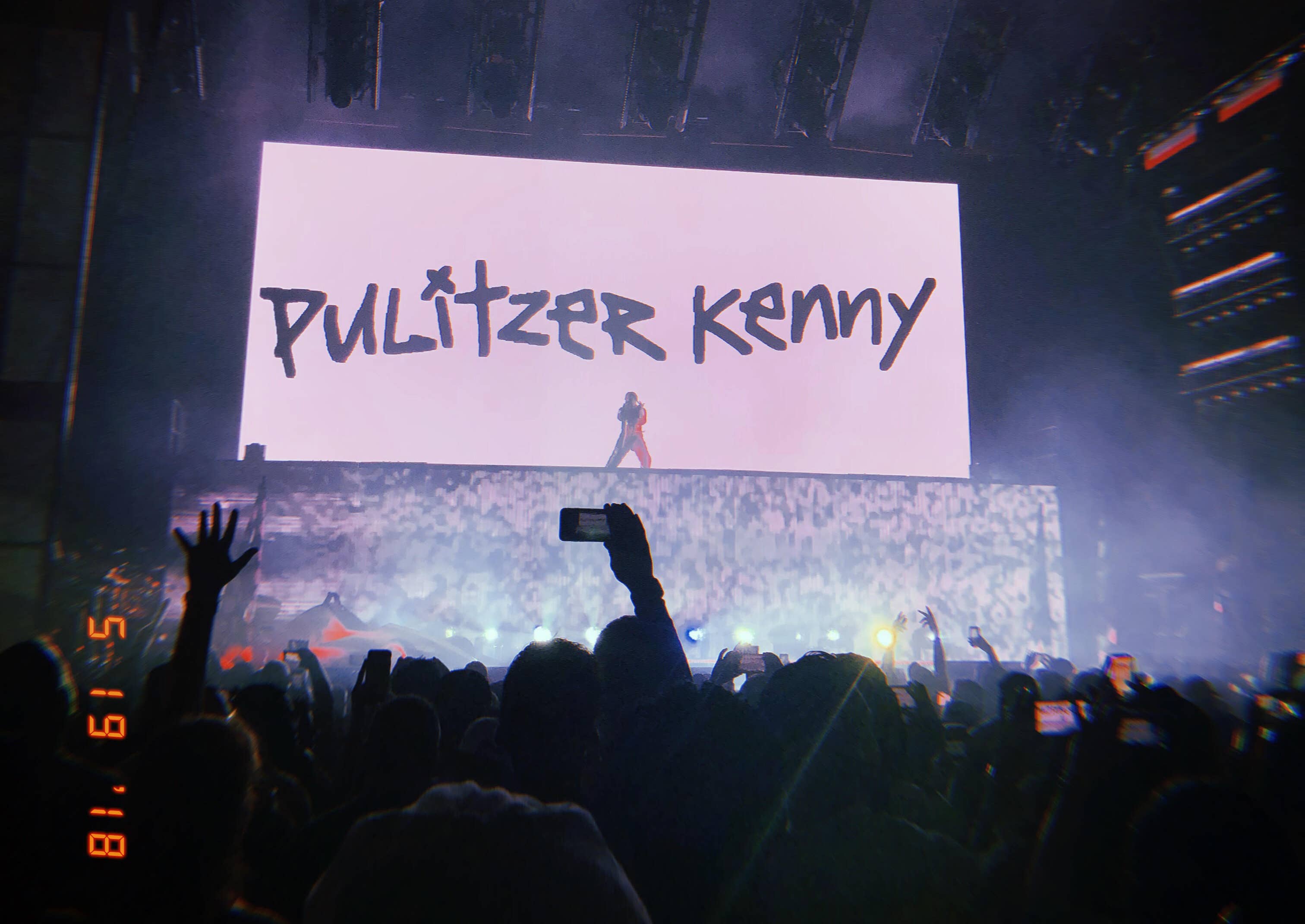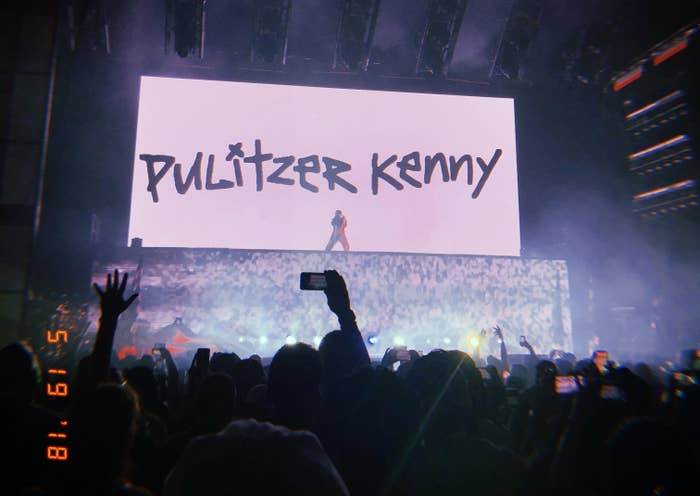
Kendrick Lamar is famously detail-oriented.
From his intricately written rhymes to conceptual music videos, he's proven he isn't the kind of artist who carelessly leaves things up to chance. Kendrick's creative decisions are made with a sense of purpose that add to a larger picture of what he stands for as an artist.
His concert visuals are no exception. To make his nightly appearance on Top Dawg Entertainment's current Championship Tour special, Kendrick recruited the assistance of Adrian Martinez and Ben Wolin of STURDY. The idea was to create a powerful set of visuals that relied on natural elements to invoke a feeling of Los Angeles culture. Using warm, surreal images that at times centered around an idea of "LA on fire," Martinez and Wolin focused on creating strong, aggressive imagery that alluded to Kendrick's SoCal roots.
Filling two large screens with natural elements like palm trees, mountains, clouds, the sun, and the moon, they produced simplistic backdrops that would create iconic silhouettes when Kendrick stood in front of them. "Some of the best silhouettes just come from nature," Wolin says. "Earth is pretty crazy, what it provides. A lot of times, the best looks are the simplest."
The tour visuals also served as Kendrick's first opportunity to publicly address his historic Pulitzer Prize win. "Kendrick's manager hit us and was like, 'Yo, Kendrick kind of wants to do this Pulitzer Kenny script for one of the visuals. Is there any way that you guys can come up with some ideas of what that could look like?'" Martinez explains. Kendrick wanted handwriting that felt like "a badass kid had drawn it," so they worked with a STURDY. team member until they had the perfect image to make the statement he wanted. "It was cool seeing how hands on Kendrick is with everything," Wolin adds. "He really cares."
For more on TDE's Championship Tour and the evolution of stage visuals in general, continue for our full interview with Adrian Martinez and Ben Wolin of STURDY.
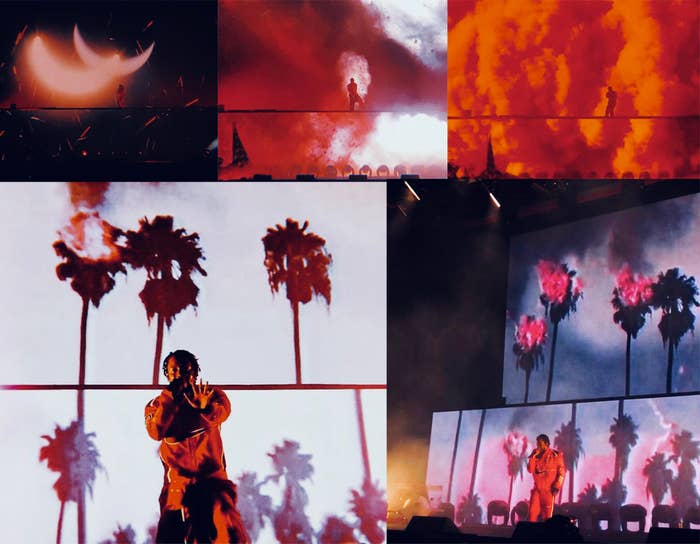
How did you guys get connected with Kendrick for this project?
Adrian Martinez: A good friend of mine named Jack Begert directs and works with Kendrick's manager on a lot of TDE content. He hit me a short time before the tour. They were really busy doing videos and other stuff, but needed tour visuals, so they asked if we wanted to take it on. It was myself, Ben Wolin, and one other guy named Connor Moy.
When Kendrick’s team first came to you guys, did they have a concept in mind?
Adrian: First we sent his team our short reel and they picked out different things that he liked and didn't like. They pretty much gave us the direction that Kendrick is an LA artist and as long as we can fit that vibe, we're good. They also said they really like stuff based on the elements. So that's where we jumped in on the footage of trees, mountains, clouds, the sun, and the moon.
What was the main feeling or mood you were trying to get across?
Adrian: I just wanted something that was hard. I wanted something that was going to be aggressive while still being true to what he represents and his LA culture. We also knew there was going to be this big screen that it would be displayed on, so we tried to think of things would build a vibe and a scene for him to live in front of. It wasn't really a story. This was more about creating a vibe that can drive the sound forward. Whether Kendrick was on the lower tier or the higher tier, we wanted him to look dope and create a cool silhouette.
Ben Wolin: Bringing in surreal elements to something that's normally a very common image is something that we try to add into most sets, too.
KENDRICK's MANAGER said they really like stuff based on the elements. So that's where we jumped in on the footage of trees, mountains, clouds, the sun, and the moon.
The visuals all felt really strong and powerful to me.
Adrian: Yeah, absolutely. We just wanted to make it feel more epic.
Ben: Some of the best silhouettes come from nature. Earth is pretty crazy, what it provides. A lot of times, the best looks are the simplest.
I noticed some allusions to Kendrick's music videos like shoes hanging from power lines and palm trees. Was that a coincidence or were you trying to tie things in with his visual world?
Adrian: We definitely knew it was on brand. That reinforced the idea. We loved the idea of the burning palm trees and it just felt so LA. Like, you drive down Wilshire boulevard or go down to Santa Monica and most city blocks will be lined with these palm trees. When we were talking about things that fit with LA, that was definitely one of them. So, how do you make it on brand and even more visually appealing? Fire is a really dope thing that always drives show visuals to the next level. So it wasn't that the music video fully made us do it, but we knew that it would fit the brand and aesthetic of what Kendrick Lamar and his movement represents.
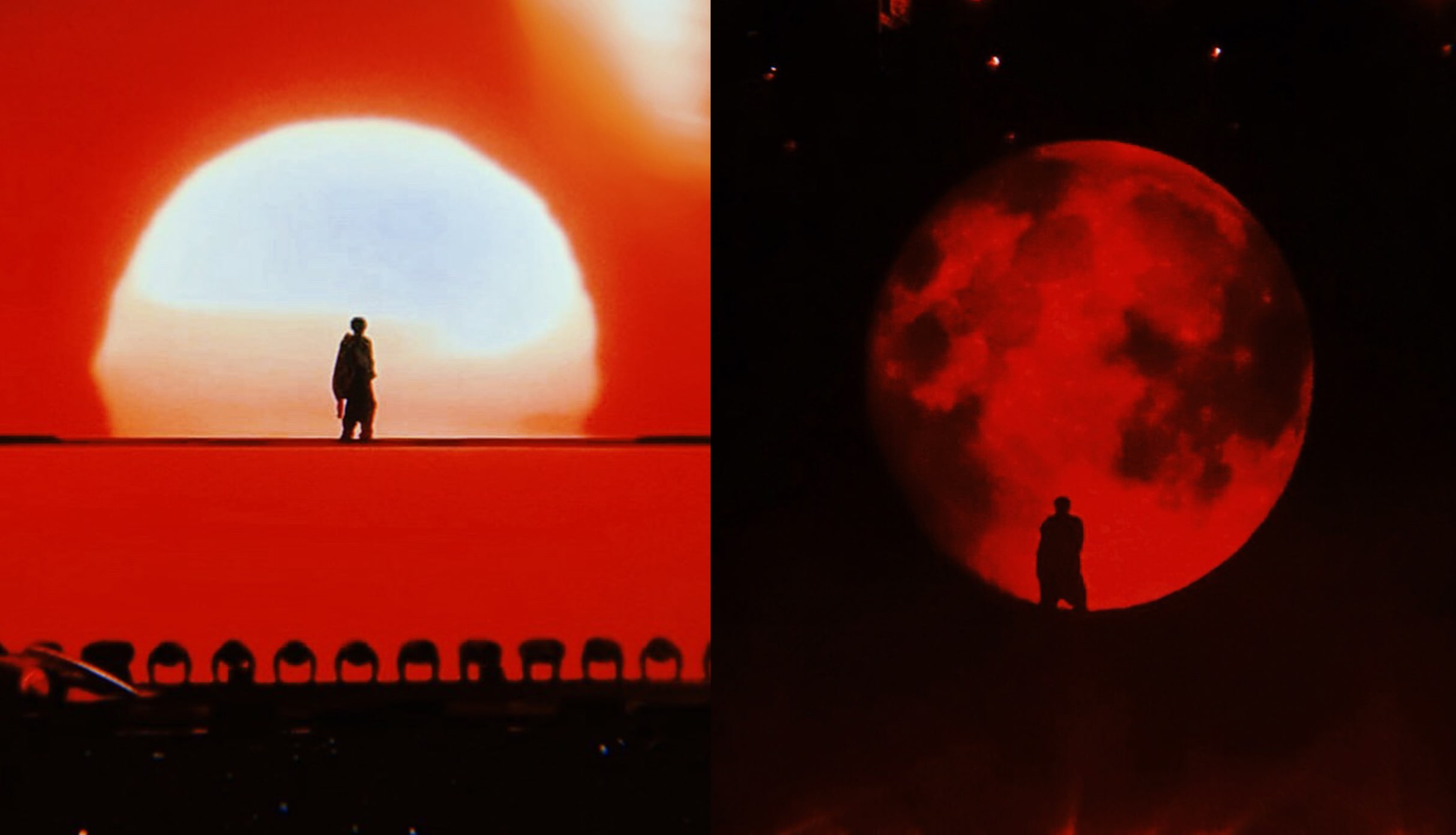
The Pulitzer Kenny part was awesome. I think that's still the only time he’s publicly acknowledged that award. Whose idea was that?
Adrian: That was a collaborative process between our STURDY. team and them. They hit us and were like, "Yo, Kendrick kind of wants to do this Pulitzer Kenny script for one of the visuals. Is there any way that you guys can come up with some ideas of what that could look like?" One of the key members on our team literally just focuses on handwritten scripts, so he drew up a few different things and sent them over. Within an hour, they responded and said Kendrick wanted a different style. He wanted something that was more aggressive but felt like "a badass kid had drawn it." I thought that was sick, so we went back again and he sent over the final options. Kendrick's so awesome to work with, man. He really acknowledged what we were doing from beginning to end. I really couldn't have asked for more in terms of being able to have such a great process of working with such a big artist.
Ben: It was cool seeing how hands on Kendrick is with everything. He really cares. He's also super empowering, for us. Not every artist is going to say, "Thank you," even.
My favorite part was the sun. I thought it would be cool, but I never thought it would be this Lion King moment. It looked so dope and Kendrick's silhouette made it perfect.
Did you have any specific reference points or inspirations that you drew from for these visuals?
Adrian: I was born in LA and I've lived there a very large portion of my life, so I definitely understand what the city is about, what it represents, and how to bring that out visually. The ideas came from looking at my camera roll, revisiting images I really like, and seeing references that I've saved on my computer. A lot of times that's how I get inspiration. I just saving images while browsing the internet so I have sort of a living mood board. Then I go back and draw inspiration from that when it's time to come up with something.
I was looking through some of your work for other tours and noticed some consistent elements, like moons. Would you say you have a style? How would you describe it?
Adrian: The moon stuff has popped up here and there. And in terms of what I like to post, that's some of the stuff that is stronger to me, so it'll be more prevalent on our pages. But I don't think we use it that often.
Again, we're fans of these more natural, real life images that are shown in abstract ways. People connect with it, too. A lot of times artists will come to you and be like, "I really like what you did with this." Then you'll figure out a way to revamp something you did previously or create a new vibe with it. Clouds have been a thing we've done a lot of stuff with. Water, too. I don't know why, but I have a crazy attraction to water-based stuff.
Ben: That's what really attracts me to visuals to begin with. How you can take the simplest thing and manipulate it a million different ways to where it can be a beautiful texture or silhouette. It's endless what you can do with the most simple things that you see every day.
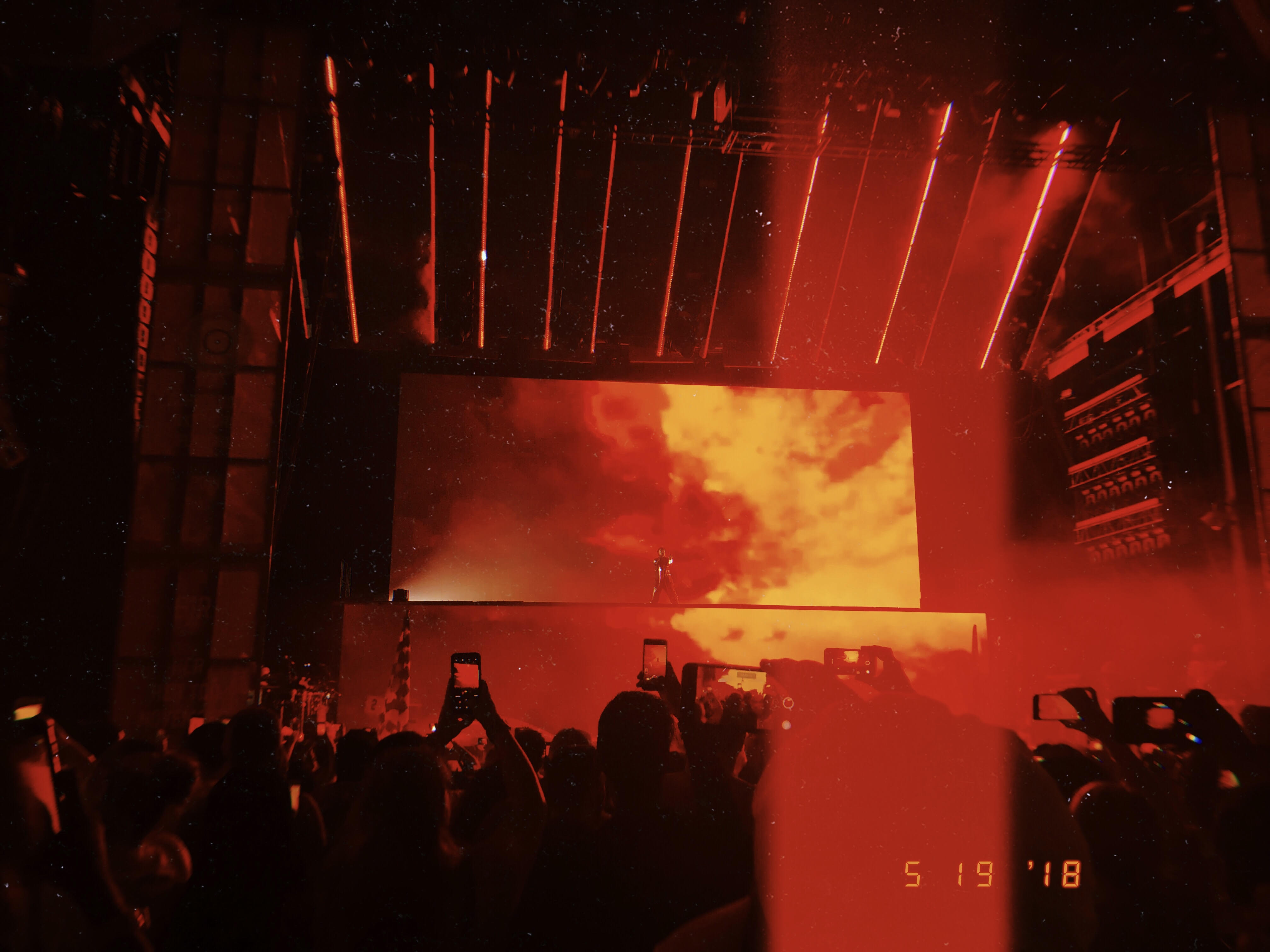
What was the timeline for this project like?
Adrian: We did it in a matter of a few days.
Ben: A big chunk of the show was IMAG stuff, though. They went heavy on the live feed IMAG stuff with effects on top. That made our job easier because it wasn't an entire set of visuals. Which I think in turn made our visuals look stronger, because it wasn't oversaturated.
How does that process work? You guys send them your visuals, then they have someone at the shows who key the live footage?
Adrian: Yeah, the VJ will mix in the IMAG whenever he wants. Those are all pre-selected looks, so for certain songs, they'll already have visuals. Sometimes they'll timecode it. Other times, they'll do a mix of the two. Depending on what they want to do, they'll go more lighting and laser-based. Then they'll do the IMAG to switch up the pace of the show. Personally, I think you need to do that because if you do too many visuals, your show gets one-dimensional.
Ben: It was cool to see how they did it. They had the show broken into sections so it was always fresh. A lot of artists will want to do everything all the time, but they were really smart about selecting when to do what. In turn, that made each section of the show stronger. It was dope working with them, because they're people I've always looked up to as far as setting the bar creatively. It was really cool seeing how they work.
It was cool seeing how hands on Kendrick is with everything. He really cares.
I noticed you guys used a lot of warm colors. Was that to bring out the LA feel?
Adrian: I was thinking about a lot of the visuals as "LA on fire." Not all of the clips were originally that color, so I was really messing with these color tones to try and keep a consistent hot red-orange. I was thinking if LA was on fire or surrounded by it, what are the colors that I would be seeing and feeling?
Ben: I think with the songs that we were working with, the warmer colors fit better, too. For some reason or another, we go warmer on a lot of sets.
Adrian: Rap sets more than others.
Ben: Yeah, that's true. When we have someone like Majid, we use cooler colors.
Adrian: With Majid Jordan we definitely used a more cold, neon approach. Someone like Carnage, though, was super fire-based, because his stuff is so bass-heavy and energetic.
Did you have a favorite visual moment in this Kendrick show?
Adrian: My favorite part was the sun. I thought it would be cool, but I never thought it would be this Lion King moment. It looked so dope and Kendrick's silhouette made it perfect. I also really liked the orange sky that was passing by. And "Pulitzer Kenny" was sick.
Ben: Yeah, I'd say "Pulitzer Kenny" was my favorite, even though it was the simplest look to execute. I just feel like crowd response-wise, that part went crazy.
Going back a little bit, how did you first get involved with tour visuals and what are some of the other tours you've worked on?
Ben: My first visuals gig was doing videography for G-Eazy back when he was starting out. I was kind of with him from the very beginning during his early touring days. We hit this tour where we finally had a screen and his management asked me if I wanted to try doing the visuals. I didn't really know what that entailed at all, but I just kind of winged it and figured it out as I went. I had a lot of fun with it and liked the aspect of it being a little more abstract. You could take the simplest thing, mess with it, and turn it into something really cool. I did a few more G tours and then started getting hit up from other people to do it.
Adrian Martinez: My first opportunity came with PartyNextDoor. I've worked with him for a few years now, since the beginning of 2015 or so. I started off as his photographer and then that evolved to other things. One of those things was tour visuals. He had his Summer's Over Tour in the fall of 2016 and that was my first try at designing a show, visually, trying to tell a progression or story. I pulled it off and he was happy with it, so I continued doing it from there.
Last year, we decided to try and get some more visual accounts and see what we could do. We were doing it on our own, but we thought if we worked together, maybe something good could come out of it. Our goal was to get four tours throughout the year in 2017. So we started off with Majid Jordan. They had a Coachella show along with some other festivals in the summer. They were super happy with it. The Coachella show turned out really well. Then from there, we jumped into Gnash. We got hired by Big Sean and a DJ named Okay. We ended up doing PartyNextDoor's again. We did Khalid, 6lack, I feel like I'm forgetting some more. But we definitely exceeded our expectations of what we even thought we'd get done.
You're creating a scene and pushing forward a vibe. The point is to never overtake what the artist is doing. You're trying to get people excited about what that moment is bringing.
Tell me about the creative agency you guys started together. What’s your goal for that?
Adrian: That's where we're working now. It's called STURDY. We've pretty much gathered a creative network over the last few years. Like I said, we were photographers and videographers, and through that we met other guys doing this stuff. Then through the creative direction I've done with Party and everyone, I've been able to bring on graphic designers and other creative directors. Then from there, when we evolved to the visual space, we jumped into animation and design of other types. So all along the way, we've linked up with people who were also doing this freelance and wanted to do cool stuff. We got along with them really well and now everyone is fully onboard to make this a real thing.
Ben: The goal with it is to bring all of our friends and collaborators together. We want to provide an infrastructure to build something bigger than just ourselves. We want to combine forces with all these people we've worked with in the past and hopefully it will streamline everything into bigger tours, bigger music videos, bigger everything.
Adrian: We've gotten some really awesome clients and accounts just from it being a thing that we're winging, but I know that together as a more solid movement, we'll be able to get gigs that we wouldn't be able to get otherwise.
Can you walk me through all the steps it usually takes to go from an initial idea to what we see on stage?
Ben: Yeah, usually they'll send us a tentative set list first. We'll vibe to the music for a bit and see what will work and also align with the branding of the specific tour and the brand of the artist themselves. Then from there, we'll mood board it. Depending on the amount of time we have, sometimes we'll dive straight in and send examples over. When we have time we'll shoot stuff or do animation. We just try to provide a vibe for each song and for the set cohesively. But at the same time, we try not to take away from the energy of the show. It's about finding a nice balance of enhancing the show and providing a nice photogenic set—but at the same time not being too extra with it.
Adrian: Some artists just want visually compelling stuff that isn't story-driven. They just want cool visuals. Other people will want to shoot stuff and tell a story. With KYLE for Coachella, we ended up writing a script and shooting intros and intermissions where he was in a rocket ship and Jay Versace was the mission control dude. It all depends. With other artists, we've shot video content that won't feel stock. Other people can only use stock and we have to figure out how to make that happen. There are so many ways to attack it, but we live for being able to create a story and creative direct a show from beginning to end. With G-Eazy earlier this year, we creative directed the set, shot original content, and designed original animated content. That was definitely a cool experience.
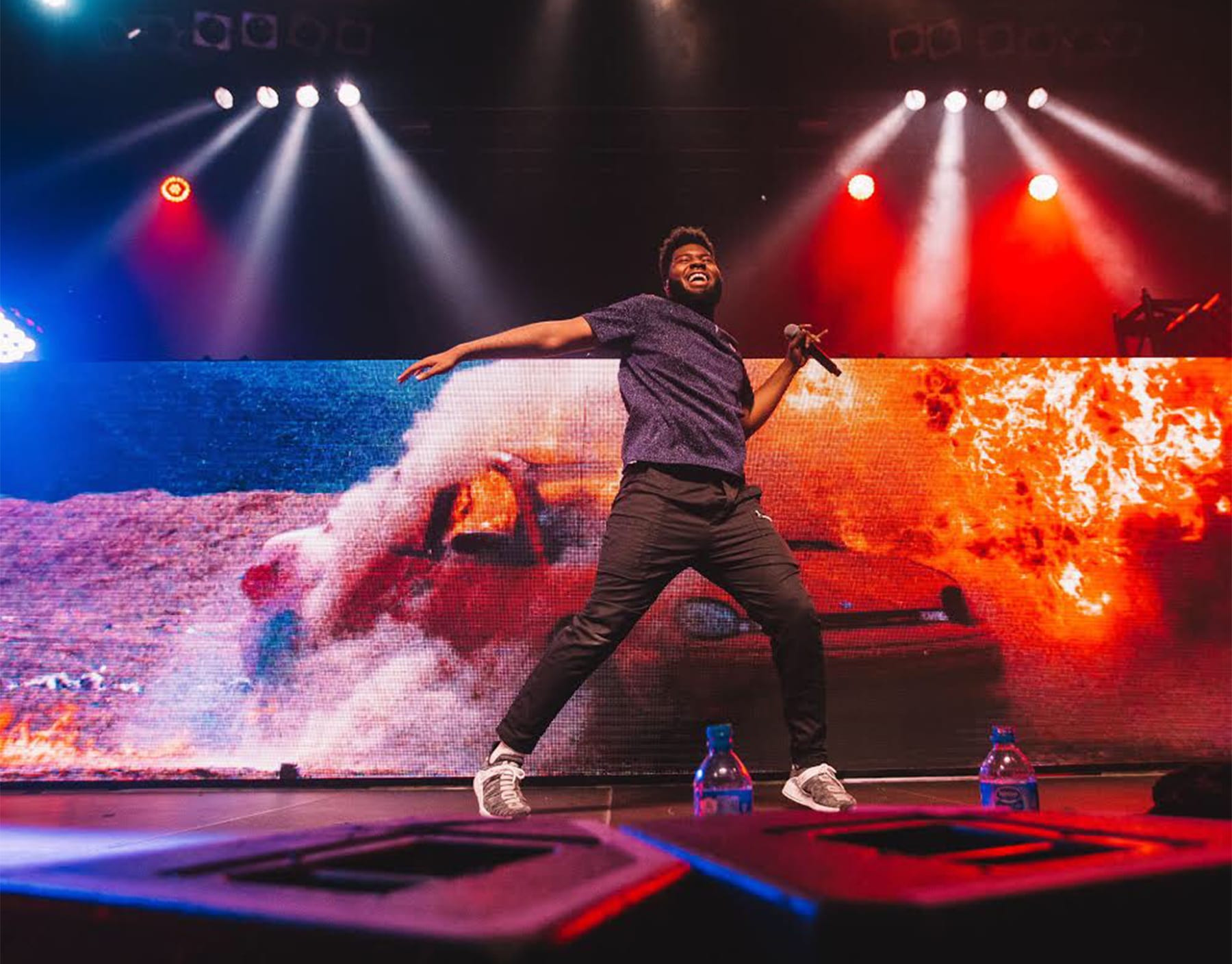
How has the art of tour visuals has changed over the years?
Ben: It's definitely become a lot more prominent in shows. I remember seeing Kanye a long time ago and he was on that wave pretty early on. I remember my mind was just blown. They had a visual of just clouds and it was like, damn, this set the whole show off. That was one of the first times I saw that, and it's definitely gotten a lot more prominent since then. Any artist playing a festival now will need that. It's also evolved because it's easier to go out and shoot stuff now. The technology has caught up. It's been interesting to see the projection world come back as well, where projectors are a real thing again. I think they look amazing.
Adrian: As far as the evolution of stage visuals, I think it started with very landscape-based stuff. If you think back to the most iconic stuff, like Ben said, the Kanye visuals that DONDA did ten years ago, those really showed what you could do with LEDs and projections. Now, I think this whole animation wave is taking over, though. I'm not saying it's forever, but artists are really loving animated content. I love it, too. People are now trying to figure out new ways to keep it fresh. Whether that's projection mapping, which takes it to a more complicated level, or do you bring it back to just a set piece and not have visuals at all? Or maybe just use color blocking...
Ben: Yeah, a lot of the time, the best looks are the simplest. It could just be a red screen. I did some stuff with YG when he was opening for Kendrick and my favorite look that we did for the whole thing was literally just a red screen. That silhouette, especially for him, was just perfect. We did all these more complicated looks, but the one that really won was just the red screen. Sometimes the simplest stuff is the best.
What would you say is the biggest role of tour visuals in general?
Adrian: You're creating a scene and pushing forward a vibe. The point is to never overtake what the artist is doing. You're trying to get people excited about what that moment is bringing. If it's a slow song, how are you helping people feel that, with colors and imagery? Or, for example, with Kendrick's "DNA," how do you help people feel that high energy? What are the colors that will enhance that?
Ben: Also, I think it's important to just make the show photogenic. Everyone's going to be taking pictures and videos of the show. How do we make it so no matter who is taking the picture—whether it's a professional photographer or a random drunk fan—they'll be able to take a good image away from it. Like, the Yeezus tour was so photogenic that anyone could take an image away from that and it would look incredible. That's always in the back of our minds. We want to make moments that are really photogenic.
